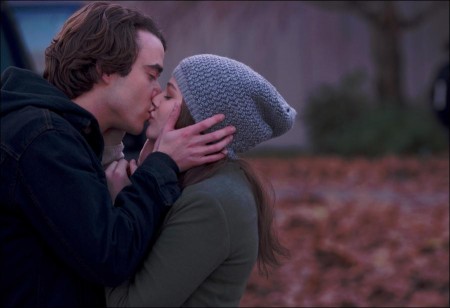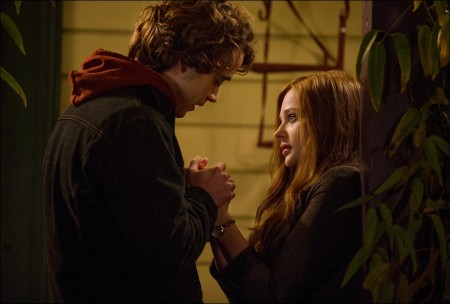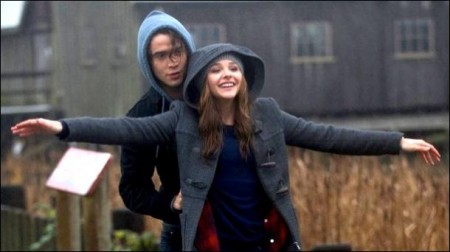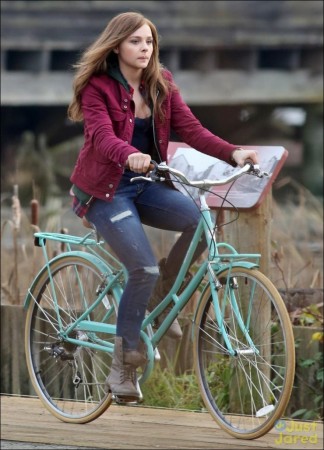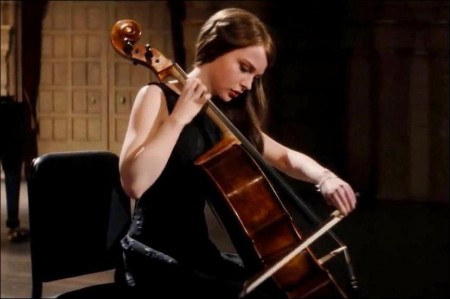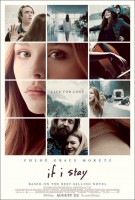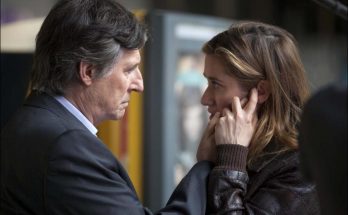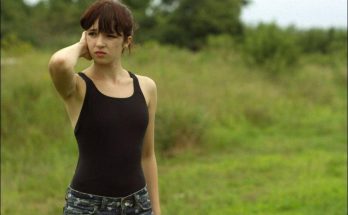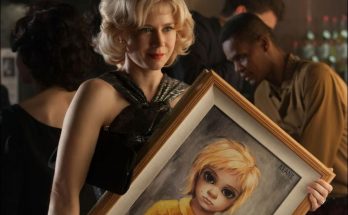Taglines: Live for Love.
Mia Hall (Chloë Grace Moretz) thought the hardest decision she would ever face would be whether to pursue her musical dreams at Juilliard or follow a different path to be with the love of her life, Adam (Jamie Blackley). But what should have been a carefree family drive changes everything in an instant, and now her own life hangs in the balance. Caught between life and death for one revealing day, Mia has only one decision left, which will not only decide her future but her ultimate fate. “If I Stay” is based on the best-selling novel of the same name.
If I Stay is an American romantic drama film directed by R. J. Cutler, based on the novel of the same name by Gayle Forman. The film stars Chloë Grace Moretz, Mireille Enos, Jamie Blackley, Joshua Leonard, Stacy Keach, and Aisha Hinds. It was released on August 22, 2014. The film received mixed reviews from critics, grossing $78.3 million worldwide.
The music was composed by Heitor Pereira. The soundtrack was released on August 19, 2014, by WaterTower Music. It peaked at number 54 on the Billboard 200 in the United States, and number 77 in Australia. All the songs for Adam Wilde’s band Willamette Stone, including the cover of The Smashing Pumpkins’ song “Today”, were produced by indie rock producer Adam Lasus.
Prelude
Mia: Isn’t it amazing how life is one thing and then in an instant, it becomes something else?
Sometimes you make choices and sometimes they make you. For reserved high school cellist Mia, it comes in an instant. One snowy drive, one horrific accident, and she is forced to make a choice only she can make, one that will make this day Mia’s defining day.
That is the storyline of “If I Stay,” based on the New York Times best-selling novel by Gayle Forman. Forman’s book has gripped Young Adult readers around the world with its enthralling love story and its unflinching look at what one young girl would do in the face of a life or death crisis that suspends her between this world and the next and presents her with an impossible choice…to stay or go?
“I read it in one sitting and it shattered me,” says director R.J. Cutler. His big screen adaptation marks the documentary filmmaker’s motion picture debut. “The central premise-we are whom we love-was so evocative, so moving, I knew I had to translate the profound connection I had with those pages to film.”
The book’s global fan base includes producer Alison Greenspan, who read the galleys of Forman’s novel before it was even printed. Greenspan was equally engaged by Mia’s conflict and relationships.
“I was captivated by Gayle’s voice, and how true it was to the young experience of grappling with love: family love, romantic love and love of self. It really spoke to my heart,” she offers.
She was also completely taken with Cutler’s vision, which he revealed in a visual presentation, complete with a CD reflecting the detailed musical palette for the world revolving around star-crossed musicians.
Greenspan was familiar with Cutler’s thought-provoking and critically acclaimed documentaries that covered pop culture from politics to fashion. She followed an instinct that the combination of Forman’s material and Cutler’s inherent understanding of it was the start of something special.
An integral part of the process was finding the person who would embody Mia. Chloe Grace Moretz was drawn to the inevitable struggle with love, hope and tragedy in the book, as well as the Young Adult fan dialogue surrounding it.
“There is so much energy swirling around If I Stay, so many teenagers and YA readers are completely infatuated with this story, so it was exciting to get involved. I was really eager for the chance to try and do justice to Mia and her wrenching conflict,” explains Moretz.
“When you fall in love for the first time, it’s all new; you can hear your heart beat from across the world for that person,” she continues. “Gayle’s book depicts that beautifully and shows how love brings out all sorts of different strengths and weaknesses, particularly when a catastrophe is involved.”
The person who becomes the center of Mia’s world-and who is also at the crux of the most significant choice she will ever make-is her boyfriend, Adam, played by Jamie Blackley.
Blackley notes, “It’s such a great story. These two people find each other because they share the same passion for music, and their relationship is nuanced and complicated and really appealed to me. But then in the blink of an eye everything changes without warning. Contemplating whether you’re ever going to see someone again and be able to say everything you thought you’d always have time to say to them is quite intense.”
In addition to chemistry, capturing the spirit of the popular book in a script was another key element. Although screenwriter Shauna Cross’s repertoire had been predominantly edgy comedies, her regard for the book and her take on it was exciting to the filmmakers.
“There was a great alchemy between her hip, vibrant voice and the heartrending nature of Gayle’s,” says Greenspan. “The script is touching and sentimental, but still grounded in reality, and that’s what Shauna brought to the table.”
The producer also made a decision early on to keep Forman closely involved. Cross enjoyed the collaborative process with the author, noting, “The novel has so many layers-it’s funny and cool and heavy and uplifting. I wanted to preserve what the fans fell in love with in the first place. You have to modify things a little, but the film is still Gayle’s world and has Gayle’s Mia; it’s her Adam, parents and friends.”
The pairing of styles proved fruitful. Forman, who also serves as executive producer, attests, “This is material I know intimately and characters that have lived in my mind for years, so, as I read the screenplay or watched on set, and got that twist in my gut I knew, for me, the book’s emotional content had successfully made the transition to screen.
“It’s been a real labor of love, I think, by a remarkable team,” she goes on. “Alison has been a champion and the moment I met R.J. I knew he saw it. He completely got the music, visuals, love story, and the characters. The cast is incredible too. It’s really the full package and I think the readers will be happy.”
Cutler adds, “Regardless of whether or not you’ve read the book, ‘If I Stay’ is a love story that takes an emotional journey exploring a fundamental truth: fate may have a hand in defining us, but so does love. And the choices we make because of that love can alter everything.” Accompaniment
Mia: Why do I have a feeling you’re about to mess up my life?
Adam: A little mess never hurt anyone.
In “If I Stay,” music is the connective tissue that threads Mia Hall’s world together. It is also “a metaphor for our passions in life,” states Cutler.
Mia’s life has always been infused with a rich soundtrack, because music has always been a priority in her house. Mia’s father was the drummer in the punk band Nasty Bruises before he became a teacher. Her mother carted Mia along to his gigs as a toddler and reveres women like Blondie’s Deborah Harry. Mia’s little brother, Teddy, who is already pretty good at drums himself, idolizes Iggy Pop. But Mia wants to play the cello at Juilliard. And her heroes are Yo-Yo Ma and Beethoven.”
Mia’s parents embraced the punk ethos of living in the moment and the messiness of life and that’s just not who Mia is-she is a girl who needs order,” explains Cutler. “She craves structure and form and it’s one of the reasons she was so attracted to the cello and why the moment she met her first cello she connected with it.”
Mia began playing cello at the age of eight and, ever since her father surprised her with her very own, she and the instrument have been inseparable.
Greenspan thought Chloe Grace Moretz was Mia. She recalls, “When I met Chloe, I immediately had the sense that she would be right for the role.”
Cutler, too, had always wanted to work with Moretz and was thrilled when she came on board.
Moretz describes Mia as “very shy and sweet. She’s a regular girl, just living her life, figuring it out step by step like everybody else, faced with normal things like being insecure, wondering if she’ll get into the school she wants to get into. Unlike everyone else, however, she just happens to feel more comfortable with her cello than with people.”
Cutler says of his lead, “Chloe carried so much of the film and always came to work with such a positive attitude. When you have a star that brings it every day, everyone else brings it, too, and it makes a big difference. I was impressed by her professionalism and how she delivered at that level.”
How Mia’s story was told intrigued Moretz even more: in flashbacks, as Mia weighs her life and relationships. “The structure was such an interesting way to frame this character. It required going through such a range of events and emotions at different times in her life. It was nice exploring those dimensions.”
Cutler remarks, “Although Mia’s family and friends are unaware of her presence, Chloe was able to evoke a tangible connection with the other characters in a way that was truly remarkable.”
Being present but unseen was one challenge for the actress. She admits the mere physical aspect of portraying an accomplished cellist was another, particularly since Moretz had never played any instrument before in her life.
Moretz spent time studying classically trained cellists to prepare for the role. She relates, “There is something so raw and beautiful about a cello because cellists literally sing through their instruments. You can hear them breathing with each bow stroke, and every time they put their finger on a new note a new part of their body moves.”
She noticed many of the cellists she met were introverted-until they began to play. “It was fascinating to watch them transform before my eyes. They become so animated and so passionate through this instrument. And that helped me with Mia, because Mia speaks through her cello,” says Moretz.
Cutler notes, “One of the things Chloe did so beautifully was capturing the essence of what it means to already be a virtuoso cellist at the age of 17. Her performance is persuasive and conveys that love of music. She really channeled the great cellists she studied.”
The director arranged for lessons with a cello instructor via Skype and in person during the busy months before Moretz would start “If I Stay.” He also wanted Moretz to have access to a cello-no matter where she was in the world.
And Moretz was all over the world. “I’d come to these new locations and there’d always be this instrument lurking around, following me. From Leipzig, Germany to the middle of Louisiana, the hotel staff would give me a strange look and say, ‘Ma’am, there’s a cello for you downstairs,'” Moretz laughs. “But actually living with it constantly made a difference since, for cellists, it really is an extension of their body.”
Although Mia has only been playing for ten years, she already seems destined for great things…and then she meets the front man for a band whose star is also on the rise.
British actor Jamie Blackley stars as the unlikely rocker who can’t resist the shy girl he hears playing the cello one day at school.
Cutler says, “When Jamie sang for us he blew us away and when he and Chloe read together we all had tears in our eyes. We all felt the same way; we had our guy.”
Greenspan adds, “I knew he had made his big break in ‘Spring Awakening’ in London, which is vocally rigorous, but listening to him sing and watching him interact in character with Chloe was incredible-the electricity in the room was palpable.”
Blackley couldn’t resist stepping into the boots of the up-and-coming musician-and onto a stage behind a microphone and guitar. “I thought it would be nice to be a rock star for a bit,” he smiles.
Cutler says, “Adam is talented beyond his years and going places and I think Jamie is, too. He’s an incredible actor and really puts a hundred percent into it. We were lucky he walked in that door.”
Greenspan also thinks they were fortunate. “Women like men who are a combination of tough and sensitive. Jamie is the perfect blend of good looks and beautiful emotions. He immediately became Adam.”
Adam and Mia don’t travel in the same circles. He’s super cool. She’s just…not. But when Adam hears Mia rehearsing, he is so mesmerized by the soulful sound he has to follow it.
“She’s like his muse. Adam doesn’t even see her at first; he’s just compelled to seek her out,” says Cutler.
“When you first meet Mia, all she has is this cello and the goal of Juilliard,” says Moretz. “No guy is going to get in the way of that. Adam comes in and pretty much flips Mia’s world on end. I mean, here’s this guy who’s a total god: he’s sexy, he sings, he plays the guitar…he’s every teenage girl’s dream.”
Although it’s a completely different style of music, Adam can’t stop watching Mia play because he can see who she really is when she lets go. Blackley notes, “It’s the music that really brings them together at first. He’s obsessed with it and he can see Mia is as well. I think when someone is good at something or cares about something, it’s insanely attractive. That goes for both of them, too, because they see each other’s passion through their respective music and that’s quite exciting for them.”
Moretz agrees that instead of love at first sight it’s love at first sound. “Mia feels the music in the core of her being, the same way Adam feels the music, and that’s intoxicating. It forges a passionate bond between them, despite how different they are, and that’s what makes them fall in love so far so fast.”
Blackley and Moretz shared a mutual professional admiration from the start. “It was such a pleasure doing our scenes because Jamie’s a brilliant actor. Our relationship felt organic and natural,” says Moretz.
Blackley, who reveals he had been a fan of Moretz’s for some time, remarks, “It doesn’t hurt that we just get on well, and laughed a lot. It was cool to actually work with Chloe.”
Mia and Adam may come from different sides of the music tracks, but it is possible for them to meet somewhere in the middle largely because of Mia’s family, who have more in common with Adam’s musical tastes than Mia.
Blackley explains, “Adam doesn’t have a family life, really, so when he goes around to their house the first time for a family dinner it’s something he’s never really experienced before. I think when he sees Mia with them he gets why she understands him so well, and did from the start.”
Mireille Enos stars in the role of Mia’s laid back mother, Kat. A travel agent since surrendering her mosh pit world for parenthood, Kat still throws bashes attended by her husband’s former band mates. “Music runs in their veins and it’s what moves them,” Enos states, revealing, “I wasn’t all that familiar with punk rock before shooting, but in researching it for the role, realized I actually liked it.”
She continues, “It’s interesting that Mia’s parents were the counterculture and now Mia is the counterculture to their world. And Adam is another version of her parent’s counterculture. So the circle continues.”
Joshua Leonard plays Denny, Mia’s still-punk-at-heart father who got a grown-up job as a teacher when the family started multiplying. Leonard reveals he is an ex-punker himself, one of only a handful of rebel kids growing up in a small suburban Pennsylvania town who listened to the genre.
He describes how the authenticity resonated with him from the start. “The first day we shot the family kitchen scene that opens the movie. R.J. had Richard Hell’s ‘Blank Generation’ blasting, a punk classic emblematic of who this family is and what kind of beat they move to-it was just one of the details that rang true to me. R.J. got the punk down…right down to the t-shirts. He’s smart as hell and a great dude.”
Although he plays a songwriter/drummer, Leonard had never played drums, so he rented a drum kit and took lessons. Jakob Davies portrays the youngest in their brood, Teddy, who is already a drummer, just like his father. Davies also took some drum lessons for his role.
Both Enos and Leonard were drawn to the cool parents whose commitment to each other is the basis of the close-knit family. “Part of what I love so much about Kat and Denny is they did have their own hopes and dreams and they wound up with this family a little unexpectedly, yet completely embraced it. No regrets. Kat and Denny love being parents,” says Leonard.
Enos adds, “They love and support each other, and they have always loved and supported Mia, especially with her musical aspirations. That love and support is their real gift to her. It’s the most important thing she needs to get through life.”
“Sometimes as a director you have this experience watching wonderful actors perform and you think to yourself, ‘there’s nothing to say, but what a privilege to be able to watch it,'” says Cutler.
Keach describes Gramps as “a hard worker, raised on a farm. He’s straightforward, sometimes gruff, and can be impatient, but he’s basically a generous, loving person.”
Gramp’s world does not revolve around music. But he does love his granddaughter and realizes she has a gift. “He’s not well-versed in the arts so he never encouraged his son to do the thing he wanted to do,” Keach allows. “He never gave Denny the emotional support that was required. I think he realizes Mia’s musical trek is his chance to make up for that.”
Mia’s extended family includes her best friend, Kim, played by Liana Liberato, whose wry humor keeps her in check; and her parent’s best friends, Willow and Henry, played by Lauren Lee Smith and Adam Solomonian, respectively, who are there for every big event in her life. And as Mia is hovering between this world and the next, revisiting memories and contemplating her relationships, Aisha Hinds, in the role of Nurse Ramirez, is determined to watch over Mia’s corporal being and bolster her will to fight.
“We were fortunate to have this wonderful ensemble that melded together so convincingly. You really invest in this offbeat family,” Greenspan states.
Cutler adds, “It’s hard to believe this group of people isn’t genetically linked because they fit together so naturally. Once you spend time with this family it complicates the stakes of Mia’s central decision as she asks herself, in the words of The Clash, ‘Should I stay or should I go?'” Bridge
Adam: Promise me we’ll spend New Year’s together next year. No matter where you are, no matter where I am.
Mia: Even if we’re in different places you’ll still be with me.
“If I Stay” was shot in practical locations in and around Vancouver, which doubled for outside of Portland, Oregon, during the fall and winter.
Cutler turned to cinematographer John de Borman and production designer Brent Thomas to execute his vision of two very distinct styles reflecting the two interwoven narrative planes of the story structure: Mia’s past memories, which tell the story of her romance with her Adam and her cello; and the present, the day the accident takes place.
“John de Borman was at his finest on a number of levels in this film. The richer color scheme for Mia’s past memories was quite a contrast to the almost monochromatic present day, which was exactly what I had envisioned in my head,” relates the director.
The sparse present-day sets a detached tone that goes hand-in-hand with Mia’s physical limitations. “In the present, Mia has an out-of-body experience. I accept that fully. Who am I to say there isn’t more?” Cutler posits, revealing he did a lot of reading about the phenomenon while fine tuning his strategy for depicting it.
Greenspan recalls, “One of the first things R.J. told me was he didn’t want this to be about visual effects. He didn’t want a character that walked through walls. He wanted it to be as grounded and real and emotional.”
To achieve that, de Borman used long lenses and shallow depth of field to give a feeling of Mia’s isolation. Another tool was a Steadicam, to create Mia’s perspective, so viewers would feel as if she is moving around the hospital in ways that wouldn’t be humanly possible.
One of Cutler’s favorite scenes is the moment where all of Mia’s family and friends first learn of her status from a doctor and a social worker. “You come floating into the scene and watch the entire thing from a specific point of view, but you don’t know at first whose point of view it is.”
Cutler dictated that only a specific vivid primary color disrupt the monochromatic post-accident present in which Mia watches and reacts without being seen: the red blood at the accident, the blue tones in the hospital.
The hospital becomes the primary location as the drama unfolds in the aftermath of the horrific accident. Thomas and his design team built the hospital set in the former psychiatric ward of an abandoned medical facility, Riverview Hospital in Coquitlam, making four separate locations on the grounds look like one cohesive unit.
In the overall design, they played a lot with glass and reflection, to represent a barrier between the real world and Mia’s in-between existence.
Thomas also designed transitional sequences at the hospital, with Mia in a glass walkway, based on an interesting photograph he found. It allowed the director to clearly represent that she is trapped between here and there.
Echoing the camera work, Thomas also utilized color: cool hues to cue the viewer they are in the present, and a fuller color prism for Mia’s pre-accident memories.
One major set piece that appears throughout Mia’s memories is her house. Thomas found the residence in New Westminster, a city just outside of Vancouver. “It was important to keep the look genuine and authentic, not affected.”
To reinforce the theme of choices creating change, the house starts with one look, and as Kat and Denny go through transitions and build a family, the feel of the house also evolves. However, one recurring color used as a prescient symbol for death or change was purple. “You see it right off the bat, center frame, the very first time we see Mia’s home, it’s the front door,” says Thomas.
Gayle Forman wasn’t prepared for the onslaught of feelings that overwhelmed her when she first stepped into the house. “I cried. I couldn’t help it; it was just so perfect. The quirky dynamic of the family was completely there. This place had been inside my head, and here it was, and I was standing in it,” she shares.
Cutler notes, “It was an honor to have Gayle there. It also gave us the opportunity to pick her brain. She gave birth to the world, so it was great to be able to get it right in her eyes.”
Overall, Cutler impressed a central concept upon his entire team that the story is being seen through Mia’s eyes.
One very prominent memory of Mia’s is her Juilliard audition in San Francisco. Vancouver’s historic Orpheum concert theatre doubled for the fictional Jolari Hall. As Mia plays Camille Saint-Saens “Cello Concerto in A minor, Op. 33” better than she has ever played in her life, it is bittersweet because she is torn between exhilaration and the feeling that she is starting a new path that is taking her further away from Adam.
For Mia’s classical music scenes, Moretz and cellist Haigan Day, who served as Moretz’s photo double, were both filmed performing and then composited in post-production.
At Cutler’s direction, the art department designed a new oval ceiling mosaic that was digitally composited onto the ceiling of the Orpheum concert hall. The recognizable image is replicated later in a pivotal moment that demonstrates the depth of Adam’s feelings for Mia.
Earlier, for their first date, Adam takes Mia to see one of her idols, renowned cellist Alisa Weilerstein, in a scene shot at the Chan Centre at the University of British Columbia.
As Mia is pursuing her Juilliard dream, Adam is chasing his own dream, and his band, Willamette Stone, is gaining popularity. Their shows required dressing Vancouver locations as well as staging crowd sequences. Since the club scenes show the ascendance of the band, the locations and sizes mirrored that. “The initial club where Mia sees Adam perform for the first time wasn’t even an actual club, rather a dingy kitchen area of what used to be an old restaurant, and it progressed from there,” says Thomas.
Cutler turned to John Carrafa, with whom he’s worked since his theatre days, to stage the musical scenes. “He did a wonderful job staging the band as well as the audiences. I think the crowds are so authentic, you really feel like you’re in those spaces.”
Cutler and his music team took care to produce all the music, both rock and classical, so it felt organic to each space, from a small dive to the concert hall at Juilliard. He offers, “It was very important to us that whether you’re in the small club with Adam, or with Mia at Juilliard in a beautiful big hall, that you feel you’re really there.”
As the film progresses the success of Adam’s band grows, culminating with a performance filmed at Rickshaw, Vancouver’s large, popular alternative rock club.
Cutler notes, “All my departments-art, lighting, wardrobe, extras casting-had to work together to illustrate this story arc and I think they did an incredible job.”
One Willamette Stone show in particular is not only a major milestone for Adam’s band, but one for Mia as well. Set during Halloween and filmed at the Cobalt night club, it’s the first time Mia lets go, dancing along in a frenetic crowd dressed in an array of costumes. For once, she doesn’t feel like the outsider in Adam’s hip world.
Greenspan says, “The Halloween concert is really where Mia comes into her own. She thinks it’s the sexy costume she’s wearing but it’s really Adam’s performance on that stage that makes her shake it up. I love that it’s not some kind of artificial tool that gets her to let her hair down but Adam’s connection to his music. It’s not about how she looks; it’s who she is that he loves. It’s a highpoint in their relationship.”
Adam’s period costume was a nod to Mia’s favorite composer, Beethoven. Costume designer Monique Prudhomme designed Mia’s ensemble to differ greatly from her daily look and comfort zone while illustrating a nice connection with her mom.
While Prudhomme did not base it on any one rocker, she acknowledges, “I took inspiration from the world of Blondie: a white china doll bob-cut wig, leopard top, very short skirt with side buckles, fishnet hose and super high red faux lizard pumps. The look resembled her mom’s when she used to go clubbing. Mother and daughter put this outfit together with clothes from Kat’s past, so it also had to look like it actually would be in Kat’s closet.”
Conversely, Mia’s closet has very simple clothes in it, almost neutral to contrast with her mother’s colorful wardrobe, conveying an effortless simplicity. Moretz’s costume for the accident and afterward in the hospital, a light layered top with a lace ballet skirt, which she remains in as she hovers between worlds, was designed to convey an ethereal feeling of lightness and transparency.
Blakeley’s wardrobe was conceived to reflect a subtle change in Adam’s coming of age as a man and musician. However, Adam’s most distinctive and telling accessory is his guitar: a Fender Jaguar Electric Guitar in live performance scenes and a Fender Guild Acoustic for the acoustic songs.
Mia’s cello in the film is a modern Romanian model instrument by Ian Moar, a local Vancouver luthier. Moar altered the top and back plates of the instrument and then finished it with a multi-layered oil varnish to give it an antiqued appearance. In addition, a petite 7/8 size Moar cello, a perfect fit for Moretz, but very uncommon and hard to find, was located for the actress.
Prudhomme had to dress Mia’s parents as both punkers in their youth and as dedicated parents almost two decades later, making a living to support their family. “Their look is a combination of what they were and what they have become, more tame but still fun and unconventional: a mixture of off-beat fashion trends of the last 20 years, which also needed to be different from Adam’s band and groups of the present,” she notes.
One of the more sentimental costume choices was using a vintage leather jacket Gayle Forman’s husband had worn in his punk days. It was shipped from Brooklyn for Joshua Leonard to wear in his Nasty Bruises drummer period.
Adam: When I was eight I saw this old video of the Ramones playing “I Wanna Be Sedated.” And it felt like my head exploded. And I was like, “I have to learn how to play the guitar.”
“If I Stay” opens with a Cello Sonata by Beethoven and riffs through an array of music including Zoltan Kodaly, Bach, Buzzcocks, Beck, Sonic Youth, Blondie, Iggy Pop, and The Dandy Warhols, to name a few.
“Music is an undeniably critical element in and of itself in this film and that created a wonderful opportunity for me,” says Cutler. “Telling stories about people who play music and who sing allows you to enhance the narrative in many different ways. You’re dealing with the content of the lyrics, the nature of the performance, and the tone of the actual scene itself. It’s really exciting to get things that function on all of those levels when you find exactly the right piece of music and put it together in exactly the right way.”
Cutler set the musical tone early, giving MP3 players to his cast loaded with playlists that their characters would be listening to, since “they are defined by the music they love,” he explains.
Moretz received one filled with music from the classical genre, as well as contemporary music that incorporated classical instruments, like Nirvana’s “Unplugged.” Cutler also included a lot of Kat and Denny’s favorite music, which Mia grew up on: The Clash, Iggy Pop, David Bowie, Elvis Costello, The Smashing Pumpkins, Pearl Jam, as well as more contemporary Pacific Northwest-based music that would likely be in the world around her.
Blackley’s playlist overlapped Moretz’s, but with less classical and more of a foundation in Punk and Grunge. Enos and Leonard’s were loaded with the music of Kat and Denny’s youth-Punk, New Wave, Grunge, and a good deal of grunge-influenced music.
Cutler also worked very closely with music supervisor Linda Cohen and the film’s composer, Heitor Pereira. They listened to hundreds of songs-some that had been written for them, some that bands had just never recorded-on a search for the five songs that Adam’s band would perform.
Adam’s musical roots, which influence Willamette Stone, begin with the Ramones. This was the point of origin that influenced Cutler’s choices for the band.
Cutler notes, “Adam’s band’s music is a kind of raw rock ‘n’ roll that has great passion and articulates a relationship to punk with a certain rage. Of course, because they’re from Portland, there’s also a relationship to grunge, so there’s a relationship to pop as well. It’s a really great merge of sounds. And Jamie and the band crushed it.”
Blackley and the other members of Willamette Stone-Ben Klassen, Ran Stephenson, Tom Vanderkam, along with keyboard player Ali Milner as Adam’s friend, Liz-arrived in Toronto weeks before the start of production to practice songs and record them for playback later in actual scenes.
“It’s fun to get up on stage and mess up your hair and have a little head bang,” Blackley smiles. “It’s mad, a total adrenaline rush.”
Although Blackley actually plays guitar and sings, he brushed up with lessons from Simon Tong, who played in the band Gorillaz. The first time Blackley got to perform the music was a pivotal scene which takes place at a Labor Day party at Mia’s house. The day Mia remembers in her retrospective state as her favorite day was also one of Blackley’s favorite scenes. Adam and his band mates play guitar with Mia’s father and his musician friends gathered around a bonfire in Mia’s backyard.
Blackley recalls, “That was really fun to film because we had worked so hard on the music.”
Adam brings out Mia’s cello and pulls her into the impromptu jam and, for the first time, she and Adam are finally playing music together, melding her classical music with his.
“It’s very symbolic. It’s like they are intertwining all the aspects of their lives,” says Moretz.
Forman relates, “Being able to actually viscerally experience watching Mia play the cello or seeing Adam and Mia actually jam together was a million times better than it could ever be in the book or in my head. I think the music is really going to resonate with viewers.”
The songs are touchstones in Mia’s memories as she studies her past in the in-between world and reflects on the complex twists and turns in her relationship with Adam.
“It’s really beautiful how R.J. infused music into every aspect of making this movie,” Moretz notes, “You hear their love story; it’s completely encompassed in the songs.”
Cutler reflects, “These two people who are deeply in love with each other, and really connected could be torn apart for no other reason than that they are fully pursuing who they are.
“Life is messy. There isn’t just one path. It’s all the joy that comes from the surprises that it has in store for you and all the tragedy that comes from those surprises. What Mia learns on her journey with Adam is invaluable and helps her make her ultimate choice.”
If I Stay
Directed by: R.J. Cutler
Starring: Chloë Grace Moretz, Mireille Enos, Jamie Blackley, Joshua Leonard, Liana Liberato, Ali Milner, Aisha Hinds
Screenplay by: Shauna Cross, Gayle Forman
Production Design by: Brent Thomas
Cinematography by: John de Borman
Film Editing by: Keith Henderson
Costume Design by: Monique Prudhomme
Set Decoration by: Louise Roper
Music by: Heitor Pereira
MPAA Rating: PG-13 for thematic elements and some sexual material.
Studio: Metro Goldwyn Mayer, New Line Cinema
Release Date: August 22, 2014
Visits: 167
